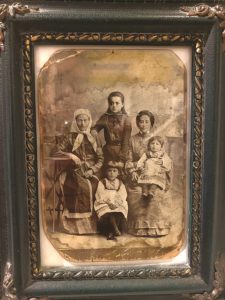
The picture at right is a family photo. It was taken in 1898 in Kyiv, Ukraine and is the original cabinet card — a thin photograph mounted on a 4¼-by-6½-inch card. It shows Bunny Pearlman’s grandmother, Jenny (or Jenya), sitting in her mother’s lap. The others are Jenny’s grandmother, at the far left — Lise King’s great-great-great-grandmother — and Jenny’s aunt and sister.
Lise carried this photo with her to Ukraine in 2014 when she was working on a documentary film project during the uprising known as the Maidan Revolution. She showed it to a few people who explained the significance of the clothing, the women’s hairstyles, and the entire scene. These were members of an upwardly mobile Jewish family that must have been well integrated into Ukrainian society. The fact that such a photograph was taken at all meant that theirs was a family of some substance, Lise was told.
The children are wearing traditional Ukrainian embroidery. Jenya’s mother’s dress is in the contemporary style, but the grandmother is wearing a traditional babushka, the old-fashioned head kerchief tied under the chin of Polish and Russian peasant women.
Between 1880 and 1920, two million Eastern European Jews emigrated to the United States. Jenny’s mother had been born in a shtetl, a farm village, near Odessa, on Ukraine’s Black Sea coast. The coming of pogroms and the persecution and killing of Jews in the early years of the 20th century led her to flee to the United States in 1917 with her husband, Sam. It was an arranged marriage — which made it easier for them to travel to the new world together. Jenny was pregnant.
Jenny went to work in the garment industry. She spoke Russian, Ukrainian, Yiddish, and heavily accented English and was literate in all of them.

Sam was an actor in the Yiddish theater in New York; he was very handsome. In the first half of the 20th century, Second Avenue was known as the “Yiddishe Broadway.” He was also a philanderer. When he knocked up a young seamstress who worked in Jenny’s sweat shop, Jenny divorced him. Now she was a single mom with two children, living in a tenement on the Lower East Side, where she copied the latest fashions from the windows on Fifth Avenue and sold patterns and samples to clothing discounters.
Lise keeps the 1898 photo of her Kyiv family on the wall of her living room and looks at it every day, thinking of the journey it has made from Ukraine to Ellis Island to the Lower East Side to Cape Cod. The photo above shows Jenny at the far right in Provincetown in 1968 with, from the left, her granddaughter Nancy Pearlman, great-granddaughter Lise Balk King, great-grandson Jack Newman, and granddaughter Bunny Pearlman.
As far as we know, all of the relatives who remained in Ukraine until World War II were killed in the Holocaust.
That knowledge has always been a heavy thing to carry and to say out loud. People react with shock when you tell them. We wonder how such cruelty could have been possible. It has always lived at a shrouded distance from us — and yet here we are again. The ease with which crimes are now being committed in Ukraine brings the old history close. Now we can see how it happened, how easily they killed our families. Just gone.
We say “Never again” in Jewish homes. Now it is our responsibility to act.
Lise King, a filmmaker, and her mother Bunny Pearlman, an artist, live in Provincetown.



